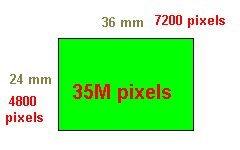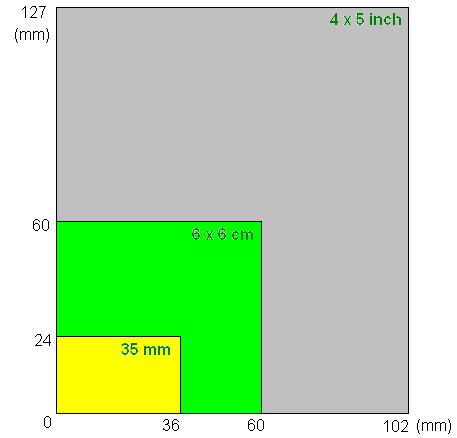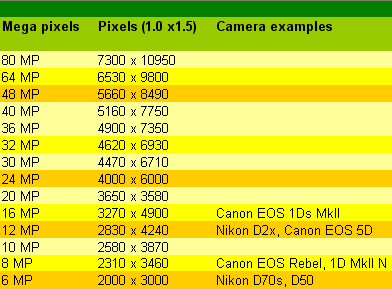|
Digital
Photography
Back to Notes on Photography General Anyone who has been exposed to the
world of digital photography will surely appreciate the benefit of this digital
technology. You can view the image the moment after you shoot the picture.
With a proper setup, you can even evaluate the result critically. The
total number of pixels on the digital sensor -- that replaces the chemical film
-- continues to increase. Today, 10 mega-plus cameras are available, and
20 mega, 30 mega, .. are just around the corner (provided the market demand
sustains the camera manufacturers' business model for
high-mega-pixel cameras). Digital-Camera/Film-Camera Comparison How does digital photography stack up with film photography in terms of the system resolution of the final image? Building on the knowledge of the previous sections, we are going to calculate how many pixels are needed to be in par with today's high-resolution films. Looking at the film resolution chart presented earlier, we see some color slide films achieve 80 lp/mm resolution at 1.6:1 contrast, and twice as much at 1000:1 contrast. Just speaking for myself, I would like to have at least the same resolution in digital photography as I get using a high resolution slide film. This would mean a minimum of 80 lp/mm. I would up an ante a bit and use a clean number, 100 lp/mm: If a digital camera gives me this resolution, I would feel comfortable converting myself to digital photography. The 35mm film size is 24mm x 36mm. The 100 lp/mm film resolution means the film surface, or digital sensor surface in digital photography, must have 100 times 2 pixels per 1 mm. (Remember our resolution unit is "line pairs", one black line and one white line, needing two pixels for each pair.) This gives (24x100x2) x (36x100x2), or 34,560,000 pixels. Now, I got my number. I need a 35 mega pixel camera!
x 100 lp/mm
x 2 pixels/lp
x 100 lp/mm
x 2 pixels/lp
Total pixel number that is required on the 24 mm x 36 mm digital sensor surface Total
Pixel Number = 4800 x 7200 = 34,560,000 pixels (35M) Note: If your film resolution
requirement is 50 lp/mm, then the same calculation gives 8,329,000 pixels.
That is, an 8 mega pixel camera will give you a comparable resolution.
(* somewhere around 16x24mm format, like Nikon's DX-format and assortment of Canon's small er sensors) How does the film format affect the image quality of the photograph in terms of resolution? To answer this question, we must first define how to measure the final outcome of the photograph. The importance of resolution boils down to how many "dots" you have in the final picture you are looking at. This may be a print you put in your family photo album, a large print you want to frame on the wall, a photograph in the book or in the magazine, or a projected image on the screen during a slide show of your last trip to Caribbean. Although the image captured on the film is generally not the final outcome of the whole photographic process, it is nonetheless a major milestone. In the following, we calculate the final total dot count captured on the film - be than chemical or digital - based on the system resolution. To be on a critical side of evaluation, we assume we are using a lens of a 600 lp/mm resolution. 1) Full 35mm Format vs. APS-C Format - Using the Same Film (100 lp/mm) Full
35mm Format
System resolution = 1 / ( 1/600 + 1/100) = 86 lp/mm APS-C Format (around 16x24mm format, like Nikon's DX-format)
System resolution = 1 / ( 1/600 + 1/100) = 86 lp/mm This is a well-known, and
predictable, result. Given the same resolution of the lens, the larger the film
format, the greater the number of dots you get in your picture,
provided the same film is available for larger formats (35mm --> 6x6
cm --> 4x5 inch --> 8x10
inch). This is true for such films as Fujichrome Velvia, but
not Kodachrome-25 or 64. In a digital world, this "same film" requirement
amounts to having the same sensor density, or the same lp/mm resolution. 2) Full 35mm Format vs. APS-C Format - Using Two Cameras with the Same 35 Mega Pixels Full
35mm Format
System resolution = 1 / ( 1/600 + 1/100) = 86 lp/mm
System resolution = 1 / ( 1/600 + 1/150) = 120 lp/mm
How many mega pixels do we need to
get the same final result (25 Mega total dot count in the picture) as the
full-frame 35mm if we stick to the APS-C format sensor size? In order to get this system resolution, we need the film resolution (Rf) of 164 lp/mm, as derived from the equation, 129 = 1 / ( 1 / 600 + 1 / Rf) --> Rf = 1 / ( 1 / 129 - 1 / 600 ) = 164. The total number of pixels to simulate this film resolution (164lp/mm) on the APS-C format digital surface is thus computed as 41 Mega pixels. To recap, the following mega pixels are needed to get the same total dot count of 25 mega on the image for the respective image sensor sizes: Full 35mm Format
Film Resolution: Rf
= (7246 / 36) / 2 or (4830 / 24) / 2 = 100 lp/mm APS-C Format Film Resolution: Rf
= (7842 / 24) / 2 or (5228 / 16) / 2 = 163 lp/mm
Soap Box
- I was rather surprised when Nikon introduced a few lenses (only
four, so far)
specifically designed for use in their APS-C format (DX-format)
digital SLR cameras. Someone
in a local photo store even told me the DX-format was going to be the main line
for Nikon. A total and absolute impossibility! The reason is simple. As
long as we are dealing with sub-10 mega pixel digital sensors, the lens
resolution has a mild effect on the final outcome. However, when we reach and
pass the 10 mega threshold, approaching the today's high-res film resolution,
the lens' optical resolution increasingly shifts its weight toward the final
resolution. Nikon cannot compete with other major camera brands with this APS-C
handicap. This leads me to believe these DX-format-specific lenses are
temporary offerings, just a stop-gap measure on the part of Nikon, to provide a
wide-angle coverage to the current users which was lost due to the 1.5x focal
length factor for the DX-format size cameras. On the other hand, if Nikon's
intent is to establish a new DX-format line, on the same lens mount, in
addition to the full-frame 35mm offering, it certainly is an interesting
business strategy. The small er image sensor size definitely have many
advantages, including a small er camera body and a small er lens size. In fact,
many point-and-shoot digital cameras achieved an amazingly compact size
employing an image sensor far small er than the DX-format. This size reduction
is unthinkable with the traditional film-based cameras. Can 35 mm Digital Cameras Overtake Large Format Cameras? (Total dot count for various film format) Proper Comparison
35mm 50mm 100mm 180mm 260mm standard lens Megapixel number of the digital sensor could go up. What mega pixel count is needed to produce a picture comparable to 4x5 and 8x10? Manufacturers have more leeway for cost in this market. 35mm photography is about a million times superior compared with 4x5 and 8x10 format cameras in terms of its system versatility.
Image Area Comparison APS-C Format 35mm 6 x 6 cm 4 x 5 inch 384 864 3600 12900 (area in square mm) 0.45 : 1 : 4 : 15 (ratio) A straight interpretation of this result is that, compared with the 35mm format, the 6 x 6 format and the 4 x 5 inch format are capable of capturing 4-times and 15-times the number of dots in the resultant image, respectively. This of course assumes the use of the same film. Also, we are assuming the same lens resolution. In order to get the same image (perspective included), we must use a lens having a correspondingly longer focal length for the larger format. For instance, a 50mm lens for the 35mm, a 100mm lens for the 6x6 cm, and a 200mm lens for the 4x5 inch, more or less, create the same "standard lens" field of view. Even so, the resolution of these lenses must be the same to capture 4-times and 15-times number of dots in the larger formats. This assumption may not be true, especially for 4x5 format optics. We have a reasonable expectation that, even for a large format camera optics, the resolution of the image center (corresponding to the 35mm frame area) is as good as that of 35mm optics. The question is whether the same resolution extends all the way to the corner of the image. The 4x5 optics requires a far larger image circle than the 35mm counterpart. Not only that, the "shift" and "tilt" operations make the lens' image circle requirement even greater. The average resolution of the entire image area for a 4x5 format camera is likely to be lower than that of the 35mm optics.
Taking pictures using a traditional film camera. Making a photographic print using a traditional enlarger. Scanning a film to make a digital image (file) Making a photographic print from a digital image (file) Taking pictures using a digital camera. Produces a digital image (file)
Requirement: 500 - 1000 exposures a day --- > Hotel download Typically, a photographer carries many rolls of film for assignment. What does this mean in the digital world? Just to get some idea as to what preparation would be needed when a film photographer converts himself to a digital photographer, let us take a look at Nikon D70 digital SLR camera that has a six mega pixel sensor. Using the RAW setting, each frame consists of 6 million pixels. Nikon D70 uses 12-bit buffer depth for RAW setting. Nikon D70 uses Nikon's NEF format that compresses this image to 5M bytes. This is a "lossless" compression: No information is lost. According to Nikon D70 brochure, you can store about 23 images (taken in RAW mode setting) in a 258 MB Compact Flush memory card. Nikon D70 - 6M pixels (RAW setting) 258 MB CF memory -------->
23 images I can shoot about 360 shots (RAW image) with one 4 GB CF memory card. To satisfy my 1000 shots per day requirement, I have to carry 2 extra cards in my pocket. This is in lieu of carrying 30 rolls of film. Nikon D2x - 12M pixels (RAW setting) If my camera is Nikon D2x with 12M pixel sensor, I would expect the numbers to decrease accordingly.... I just have to carry twice as many memory cards! 2 GB CF memory ----------> 90
images Hotel Download After exhausting several 4GB memory
cards, I must download the image data to my laptop or some storage device, so
that I am ready for the next day's shoot.... Maybe, the modus operandi for
a future digital photographer is to upload the image data to a secure site
wirelessly, using a transmitter attached to the camera. This is no
different from NASA receiving pictures from Mars Rover taken by an on-board
Nikon...... Storage Requirement (Slide vs. Digital) I can keep 40 or so slides (mounted on the standard paper mount) in a 1 x 2 x 4-inch box returned from Kodak or Fuji processing lab. Where do I keep my digital images? Storage Cost Comparison - Cost per Gig byte:
USB External
Internal CD-ROM
DVD Capacity 258MB 200GB 200GB 700MB 4.7GB Price $50 $250 $150 $0.20 $0.50 Cost/GB $200/GB $1/GB $0.75/GB $0.30/GB $0.10/GB The comparison shows the DVD disk is the cheapest storage medium, and probably the most stable. I just have to make a copy every 5 years or so to avoid the disk deterioration, and/or to keep my eyes open for new software/hardware technology, including image format obsolescence. Soap Box
- I kept my slides (Kodachrome-25) for the
past 30-some years very successfully. The transparencies retained their
original color quite well. I am not so confident if I can manage to keep
my digital image that I took yesterday for the next 10 years!
Nikon D3 / Nikon S1 There are many sites in the web making interesting predictions about new digital cameras. Some sites I saw predict Nikon D3 to be a full-frame 35mm digital SLR camera. Here is my two cents. As I wrote somewhere in my Soap Box, Nikon DSLR will eventually go full-frame. Canon has EOS 1D series and there are other brands using a full-frame 35mm format. Nikon's decision to use a APS-C format for their new, top of the line DSLR camera, D2x, is probably based on their careful analysis (both technical and marketing) that they can still compete well with a full-frame 35mm format at the current sensor pixel count, which is around 12M (Nikon D2x) and 16M (Canon EOS 1Ds Mark II). As the market push continues to increase the sensor resolution beyond 20M pixels, however, the disadvantage of a small er sensor size becomes more difficult to overcome. Nikon has to move to the full-frame 35mm DSLR market, and, doing so is fairly easy. All Nikon has to do is to produce a "camera"; all the 35mm lens lines are available - they have been for many years. That having been said, my two cents is merely a naming of the new camera. Whether it was
intended from the very beginning or not, the fact of the matter is that the APS-C
format market has been established. (I am just using the term "APS-C format" to
mean Nikon's 23.7 x 15.7mm and Canon's 22.5 x 15mm and so on.)
I think the APS-C format started out as just a stop-gap measure because of the
huge cost of the large sensor in the past, but regardless, it now has a life of its
own. There is no reason for Nikon, or any other manufacturers, to abandon this
new APS-C format line. They should continue to foster this market. So coming back to
Nikon D3 naming. I do not think Nikon will remove the APS-C format from the
professional lineup. That is, my prediction is D3 will be another generation of
a professional APS-C DSLR. Nikon will simply have to pick another letter from the
alphabet soup, say, "S", for their new full-frame 35mm DSLR, so as not
to disturb the APS-C digital line. Nikon is more conservative and more careful in
their product planning than Canon (just my opinion). Nikon has maintained their
lens mount unchanged from the days of Nikon F. Nikon seems to be keeping the
tradition of careful thinking in their sensor size decision. When Nikon introduces a new
full-format 35mm DSLR camera, it will be a monumental event. The Nikon
S1 will be a 25M pixel full-frame 35mm DSLR camera, but don't hold your
breath. Nikon will take their time before bringing this to the market. Nikon
realizes very clearly that the sensor pixel count is just a small part of the
overall equation in the professional arena that they serve. This is shown in
their latest introduction of Nikon D2Hs. The D2Hs sports 8 frames per second
firing, though the sensor is limited to 4.1 mega pixel. When Nikon
introduces S1, it will shoot just as fast at a 25 mega pixel sensor.
|
| Carnivorous Plants Photography Web Site: Copyright © 2001-2018 Makoto Honda. All Rights Reserved. |








